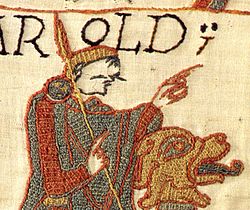
Back Harold Godwinson Afrikaans Harold Gōdwines sunu ANG هارولد جودوينسون Arabic هارولد جودوينسون ARZ Harold Qodvinson Azerbaijani هارولد قادوینسن AZB Гаральд II Годвінсан Byelorussian Гаральд II Годвінсан BE-X-OLD Харолд Годуинсън Bulgarian Harold II (Bro-Saoz) Breton
| Harold Godwinson | |
|---|---|
 Harold Godwinson, from the Bayeux Tapestry | |
| King of the English | |
| Reign | 5 January – 14 October 1066 |
| Coronation | 6 January 1066 |
| Predecessor | Edward the Confessor |
| Successor |
|
| Born | c. 1022 Wessex, England |
| Died | 14 October 1066 (aged about 44) near Senlac Hill, Sussex, England |
| Burial | Waltham Abbey, Essex, or Bosham, Sussex (disputed) |
| Spouses | |
| Issue | |
| House | Godwin |
| Father | Godwin, Earl of Wessex |
| Mother | Gytha Thorkelsdóttir |
Harold Godwinson (c. 1022 – 14 October 1066), also called Harold II, was the last crowned Anglo-Saxon King of England. Harold reigned from 6 January 1066[1] until his death at the Battle of Hastings on 14 October 1066, the decisive battle of the Norman Conquest. He was succeeded by William the Conqueror, the victor at Hastings.
Harold Godwinson was a member of the most powerful noble family in England, his father Godwin having been made Earl of Wessex by Cnut the Great. Harold, who served previously as Earl of East Anglia, was appointed to his father's earldom on Godwin's death. After his brother-in-law, King Edward the Confessor, died without an heir on 5 January 1066, the Witenagemot convened and chose Harold to succeed him; he was probably the first English monarch to be crowned in Westminster Abbey. In late September, he defeated an invasion by rival claimant Harald Hardrada of Norway in the Battle of Stamford Bridge near York before marching his army back south to meet William in Hastings two weeks later.
- ^ DeVries 1999, p. 230.